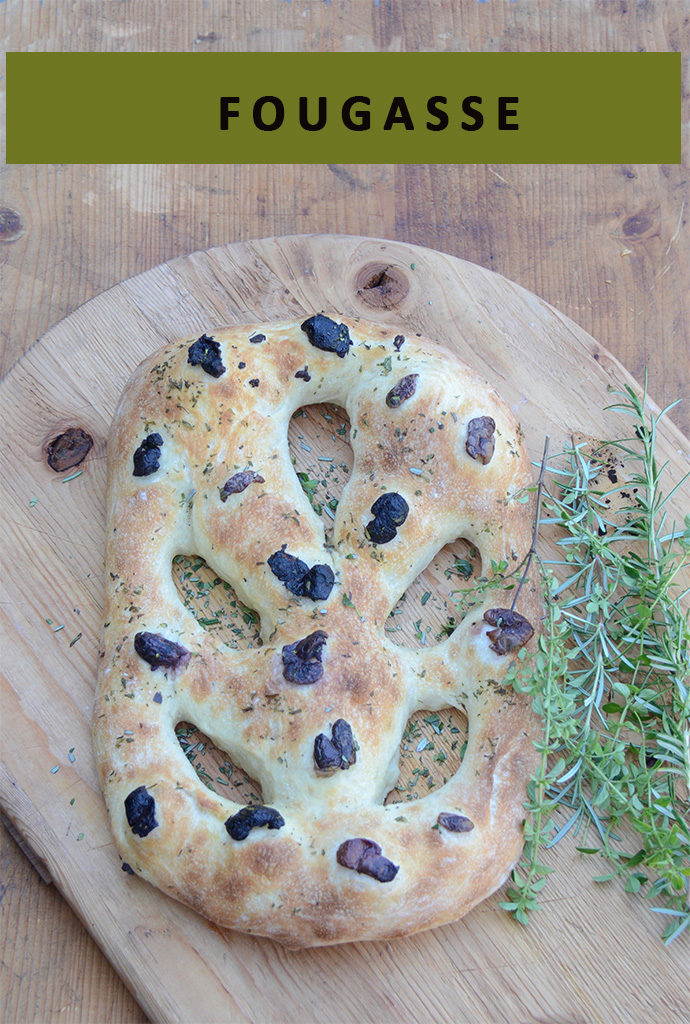
Fougasse with olives, thyme and rosemary
Baking bread feels so authentic, so fundamental to cooking. Just think of all the cooks over millenia baking bread for their families and communities all over the world. I don’t bake bread all the time but as is my style, every now and then I go all in and bake all kinds of breads for a while and then move on to something else until I revisit this art again.
The inspiration for this round of bread baking was dinner at God’s Mountain catered by the one and only Dana of Joy Road Catering. Dana is a true treasure and we are so lucky here in the Okanagan to have her and her partner Cameron offering fabulous dinners in vineyards and throughout the valley from spring until fall.
We were guests at the Joy Road dinner last week and as always, they had their signature fougasse on the table, ready for us to tear a piece and break bread with other guests. I love this ritual and when I came home I had fougasse on my mind along with a few other crusty loaves of bread, perhaps not all at the same time, but over a few days. I started with the no knead bread, baked in an enamelled cast iron pot in a very hot oven. That loaf was a success, so much so that it was gone before I had a chance to take any pictures. Next on the list was this fougasse, and thankfully no one devoured it before I took the pics, hence this post.
Fougasse is a French bread, the counterpart to the Italian focaccia perhaps, and historically was baked on the ashes of fires they cooked their foods on. I was watching a program on Netflix, “A Cook Abroad”, about cooking in South America and they too have a similar flatbread baked on the ashes. Fougasse is crispy on the outside, chewy on the inside and has a lot of crust surface for those of us who love crusty breads.
When it comes to making bread dough it’s hard to give exact quantities so you have to develop a feel for the dough. Sometimes it takes more flour/water than others. In principle, you want to add as little water as the flour will absorb. I also add olive oil to this dough, to enhance the flavour and make the texture easier to handle and more and supple.
On another note, we are on the last stretch before the Baltic and Icelandic adventure. I look forward to seeing a part of the world I haven’t seen before, new sights, sounds, aromas and flavours. I hope to report as we go, intending to take the laptop along although it would be easier with less electronics. I am currently immersed in 17th century history of the Baltic with all the young (in their 20’s) and apparently handsome (for the time) kings (Peter the Great of Russia, Augustus of Poland, Charles of Sweden) who were fighting wars over territory along the Baltic Sea. Very interesting stuff and I am glad I wasn’t born in that era. Life was rough even for the aristocracy, a lot of great egos involved. It makes excellent reading and good preparation for visiting the area.
So, enjoy the fougasse recipe, even if it only inspire you to cook something else.
Ciao ciao.
Ingredients:
1 1/2 cups water
1 packet yeast
1 teaspoon sugar
2 tablespoon olive oil
3 1/4 cups flour (or as needed)
1 tablespoon coarse sea salt
Green or black olive, pits removed
A handful of fresh thyme and rosemary, chopped
Coarse salt for sprinkling over the fougasse
Directions:
Making the dough:
Combine water, yeast and sugar and let the yeast activate and foam.
Place in a stand mixer with a dough hook and mix.
Add the oil.
Mix the flour and salt together.
Start adding the flour, a little at a time while the machine is running until the dough gathers together.
Continue kneading a couple of minutes more, then remove and finish the kneading by hand, adding flour as necessary to create a soft but not too sticky dough.
Place in an oiled bowl, cover and let rest until doubles in size, about 2 hours.
You can proceed with the recipe now or punch the dough down and refrigerate until the next day. Bring back to room temperature before proceeding.
To form the fougasse:
Without punching the dough down stretch it into a rectangle, not too thin and lay on a sheet of floured parchment.
With a sharp knife make a few cuts as you see in the images: one vertically from the top going towards the center and four more diagonal cuts below. Pull apart the cut areas so they do not close when you bake the fougasse.
Brush the dough with olive oil and then press the olives onto the dough and scatter the chopped herbs over and the coarse salt.
Let the dough rest for about 20 minutes.
To bake:
Bake in a 450-500F oven preferably on a baking stone. You should turn the oven on about an hour before you plan to bake, to make sure it is nice and hot.
I transfer the fougasse into the oven by sliding a large metal pizza peel under the parchment and sliding the whole thing onto the baking stone as is. You can always pull out the parchment after a few minutes of cooking (not too soon) or leave it to cook over the parchment.
Bake 20-30 minutes or until golden, crisp and cooked through.
Enjoy.



Comments are closed here.